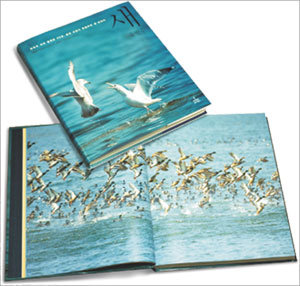Birds

The Eyes of Birds-
The author (64 years old) has been taking pictures of birds since 1961. Out of 300,000 photos of birds, 300 were published in the book. The purpose of the inclusion is not to identify specific species of birds. As stated in the authors preface, it is to show the beauty of life that is hidden behind the veil of birds exhausting ways of life.
The book is not for the appreciation of the beauty of birds, but for appreciation of how they lay eggs, build nests and desperately fight for their lives.
And their way of life can be seen right in their eyes. A free-flying snowy herons homely eyes, an Indian kingfishers eyes that are fixed upon the movements of a fish while it is perched on rocks next to a stream, the eyes of a little ringed plover who settles down on the ground instead of building nests when a pair mates on the ground, and a hoopoes eyes with a mole cricket, its prayer, in its mouth.
Some might think, What look can there possibly be in birds eyes? looking at the photos. But the reader will soon find himself or herself overcome by a feeling that those eyes are telling the reader something. Hey, folks. Like all of you, we live. Alongside you.
Just like what Robert Capa, one of the best war cameramen, said, the writer must have been able to take pictures of those eyes because the author had come up closer to the birds.
The Love Life of Birds-
Birds chirp for the purpose of courtship during breeding season. However, even birds, which belong to the same species, sing differently depending on the location. Birds have dialects. Though male birds sing, they stop singing once they win the hearts of female birds.
Singing is not the only facet of bird courtship. Homely birds as well as pheasants whose feathers are lovely put on stage outfits of splendid feathers during breeding season. Couples of little grebes glide over the surface of the water, dancing, and Indian kingfishers and little terns get their female partners fish or mud snails. Particularly, Indian kingfishers strike the heads of fish against rocks before they put their preys into the mouths of female kingfishers head first. Even birds know that the upper part of a fish is delicious. Cranes are never behind in giving gifts to their mates. They catch king crabs, remove the claws, and wash them before giving the crabs to their chosen females. Moreover, fan-tailed warblers or wrens even dangle nests to attract mates. Well, I have a house, they brag. They do just what humans do.
The book is centered on the photos, however, not those stories. Readers can feel the patience and tenacity of the author.
A Birds Life-
In the book, there is a picture (pg. 178) that resembles the recent aftermath of a terrorist bombing. Feathers of a Chinese Little Bittern are scattered about on the ground and red blood is sprayed everywhere. A headless bird is all that is left. The caption next to it explains what happened. A hawk devoured the bittern, a bird as big as itself, for breakfast.
Birds do not gracefully die away in cages after being fed grain and water. These photos contain the real lives of birds. They eat to live and feed to nurture their offspring. Death is an everyday occurrence in their lives.
With the exception of the time they sleep, birds spend the rest of their waking hours feeding. After the breeding period, birds use 80 percent of their waking hours eating. Swallows and sparrows bring food to their chicks 600 times a day.
Birds play games, too, for fun. A crane will repeatedly throw a kernel of corn into the air with its beak to catch it with its claws. A crane is photographed jumping around quite merrily in a photo.
The names of birds are listed again. Some of them may sound familiar. Black kites, brown hawk-owls, storks, Merlins, Paradise Flycatchers, Hobbies, Ural Owls these are the names of nearly extinct birds. I would like to quote a slogan from the World Wildlife Fund (WWF) to appeal to you, the readers: They Die, You Die.
mindy@donga.com






![[사설]참 구차한 김병기 전 원내대표](https://dimg.donga.com/c/138/175/90/1/wps/NEWS/IMAGE/2026/01/13/133151454.1.jpg)
